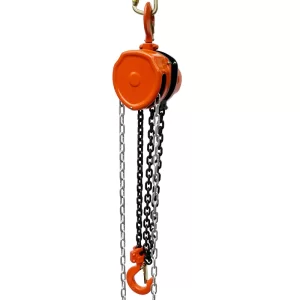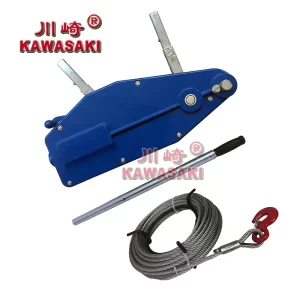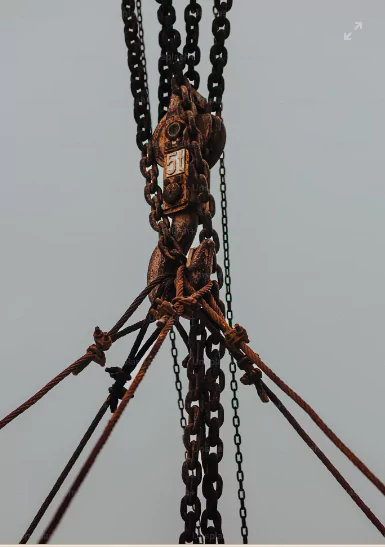Rope hoists andchain hoists are two fundamental types of lifting devices, each designed for specific applications and environments. Understanding the differences between them is critical for selecting the appropriate equipment for various material handling tasks. This article delves into the essential distinctions between rope hoists and chain hoists, focusing on their components, mechanisms, performance attributes, and operational efficiencies. By examining these aspects in detail, readers will gain a comprehensive understanding of these two types of hoists and their respective applications in industrial settings.
Overview of Rope Hoists and Chain Hoists
Defining Rope Hoists
Rope hoists utilize a rope as their primary lifting medium, which can be made from various materials, including steel wire and synthetic fibers. This type of hoist is typically lighter and more flexible than its chain counterparts, making it suitable for lifting lighter loads in confined spaces or overhead applications. Rope hoists are often employed in construction, theater rigging, and marine applications where maneuverability and ease of deployment are essential.
Defining Chain Hoists
Chain hoists, on the other hand, rely on a chain for lifting and lowering loads. These devices are robust and capable of handling heavier weights, making them ideal for industrial environments. Chain hoists are often found in manufacturing plants, warehouses, and construction sites due to their durability and reliability. They can come in manual or electric configurations, offering enhanced efficiency in lifting heavy machinery or materials over considerable heights.
Key Components and Mechanisms
Basic Construction
In examining the basic construction, rope hoists often comprise a winding drum or spool to manage the rope, while chain hoists feature a chain wheel. The choice of lifting medium—rope versus chain—significantly influences their design and functionality.
Lifting Medium: Rope vs. Chain
The rope provides a lightweight and flexible option, allowing for intricate lifting operations and easier use in tight spaces. However, it may not offer the same load capacity as chains, which are built for strength and resilience. Chains are less flexible but provide superior gripping and stability during heavy lifts.
Motor and Gear Systems
Rope hoists can be powered by a variety of motor options, often utilizing gear systems that allow for precise control and adjustments. Conversely, chain hoists often include either manual gears or electric motors, both of which support effective lifting speeds and adjustments as required by the task.
Operational Principles
The operational principles of rope hoists and chain hoists differ primarily in their lifting mechanics and the types of loads they are designed to handle. Rope hoists primarily focus on lighter, more versatile lifting tasks, while chain hoists bear a reputation for efficiently managing heavier loads with a straightforward lifting mechanism.
Performance Attributes
Load Capacities
When it comes to load capacities, rope hoists typically have lower limits compared to chain hoists. Rope hoists can safely lift loads ranging from hundreds to a few thousand kilograms, depending on the design and material quality. In contrast, chain hoists can lift significantly heavier loads, often exceeding several tons, making them preferable in industrial and construction settings.
Speed and Efficiency
Speed and efficiency are key considerations in selecting lifting equipment. Rope hoists may outperform chain hoists in operations requiring frequent adjustments and quick lifts, while chain hoists offer sustained power and speed for maximum lifting efficiency over longer durations. The operational speed can significantly affect turnaround times in a work environment, especially when multiple lifts are required.
Durability and Maintenance
Durability is another crucial aspect where chain hoists often excel due to their robust construction, designed to withstand harsh industrial environments with minimal wear. Rope hoists, while generally easier to transport and deploy, may require more frequent inspections and replacements due to wear and tear over time. Maintenance considerations are vital, as proper care can extend the lifespan of both types of hoists.
In conclusion, understanding the differences between rope hoists and chain hoists helps professionals choose the right lifting equipment for their projects. The performance attributes, operational principles, and key components discussed provide essential insights into optimizing material handling efficiency.
Application Scenarios
Industries Utilizing Rope Hoists
Rope hoists find extensive application in a variety of industries that require flexibility and controllable lifting mechanisms. Commonly used in construction, they offer the advantage of providing smooth lifts in tight spaces. The entertainment sector, particularly in theater rigging, benefits from the lightweight characteristics of rope hoists, allowing for intricate stage setups without obstructing sightlines or movement. Additionally, rope hoists are suitable for marine applications, where versatility and portability are essential due to varying load conditions and environmental factors.
Situations Suited for Chain Hoists
Chain hoists are ideally suited for situations demanding heavy lifting capabilities and durability. Industrial manufacturing environments commonly utilize them for moving large machinery and equipment, where the strength of the chain is crucial. In construction settings, where safety and reliability are paramount, chain hoists are preferred for lifting and lowering significant loads. Furthermore, warehouses often employ chain hoists for repetitive lifting tasks, leveraging their consistent performance to enhance operational efficiency in material handling.
Advantages and Limitations
Benefits of Using Rope Hoists
Rope hoists present several benefits, particularly where space and flexibility are concerns. Their lighter weight allows for easier maneuverability, making them suitable for temporary setups or projects requiring frequent relocation. Additionally, the reduced risk of load damage in delicate operations is a significant advantage, as the softness of the rope minimizes the potential for scratches or dents on the lifted items. The flexibility of material options—such as synthetic or wire rope—further enhances their adaptability to different lifting conditions and environments.
Strengths of Chain Hoists
On the other hand, chain hoists have notable strengths that cater to heavy-duty lifting applications. Their robust design affords a high load capacity, making them an essential choice for industries that require the lifting of substantial weights. Chain hoists also demonstrate exceptional durability, allowing them to operate in harsh conditions without significant wear. Furthermore, the ease of maintenance associated with chain systems ensures longevity and reliability, which is critical in commercial and industrial settings where downtime can result in considerable productivity loss.
Safety Considerations
Safety Features in Rope Hoists
Rope hoists incorporate various safety features designed to protect users and loads during operation. One prominent feature is the overload protection system, which prevents excessive weight from being lifted, thereby reducing the risk of equipment failure or accidents. This function is critical in applications where load limits may frequently be tested. Additionally, emergency stop functions are vital for immediate cessation of lifting operations in case of malfunction or emergency, further enhancing operational safety.
Overload Protection Systems
Overload protection systems in rope hoists act as an essential safeguard against mishaps. These systems are engineered to detect when the applied load exceeds the hoist’s rated capacity. By automatically halting the operation when a limit is reached, they prevent potential damage to both the hoist and the load being lifted. Such measures are imperative in dynamic environments where fluctuating load conditions could otherwise jeopardize safety.
Emergency Stop Functions
Emergency stop functions are a critical component of a rope hoist’s safety arsenal. These functions allow operators to immediately deactivate the hoist in unforeseen circumstances, such as equipment malfunctions or human error. Implementing such a safety feature significantly reduces the likelihood of injury to personnel and damage to equipment, fostering a safer working environment.
Cost Implications
Initial Investment Costs
When considering the initial investment costs, it’s important to recognize that both rope hoists and chain hoists have varying price points based on technology, design, and load capacity. Rope hoists tend to be priced more affordably, making them an attractive option for businesses that need flexibility without a significant financial outlay. In contrast, chain hoists, particularly those intended for heavy-duty applications, may demand a higher upfront investment due to their robust materials and construction.
Long-term Maintenance Costs
Long-term maintenance costs are a significant factor in managing the overall expense of hoists. Rope hoists, while generally less expensive initially, may entail more frequent maintenance checks, as the ropes can wear out more quickly, particularly in rugged operational conditions. Regular inspections of the rope integrity and proper care practices are essential to ensure safety and functionality. Chain hoists, backed by their durable design, often incur lower maintenance costs over time as they withstand harsh conditions without compromising performance. However, it is crucial that users keep up with routine maintenance schedules to ensure all components, including the chain and motor systems, are functioning optimally, as neglect can lead to more substantial long-term repair costs.
Choosing the Right Type for Your Needs
Evaluating Project Requirements
Selecting between rope hoists and chain hoists requires a detailed evaluation of your project requirements. Factors such as load weight, lifting height, available space, and frequency of use must be considered. For projects involving frequent relocation or specific lifting configurations, rope hoists offer the agility and maneuverability needed to navigate tight spaces. Conversely, for projects demanding consistent heavy loads over long durations, chain hoists provide the durability and reliability necessary for efficient material handling.
TheKAWASAKI MANUAL HOIST CHAIN HOIST CKfeatures a customized design to suit various operational needs while ensuring robust performance. Simultaneously, the KAWASAKI MANUAL HOIST WIRE ROPE HAND HOIST NHS presents a versatile solution with options for various lifting capacities and customizable features, enhancing its usability across diverse applications. Whether you require the strength of a chain hoist or the flexibility of a rope hoist, these products deliver exceptional reliability and performance.


Understanding the Work Environment
Another crucial aspect to consider is the work environment in which the hoist will operate. Rope hoists are particularly well-suited for environments where versatility is paramount, such as in construction or stage rigging scenarios. The lighter weight and flexibility of rope allow for extensive applications without the burden of heavy machinery. In contrast, chain hoists excel in more demanding industrial settings where the lifting of heavy equipment is common. Their robust construction allows them to operate efficiently in harsher conditions while requiring less frequent maintenance, hence enhancing productivity.

